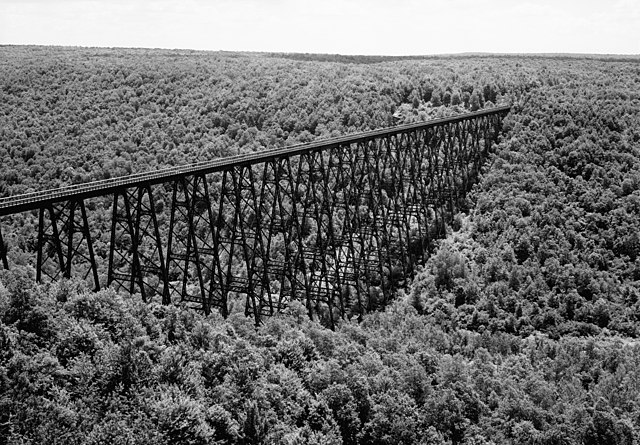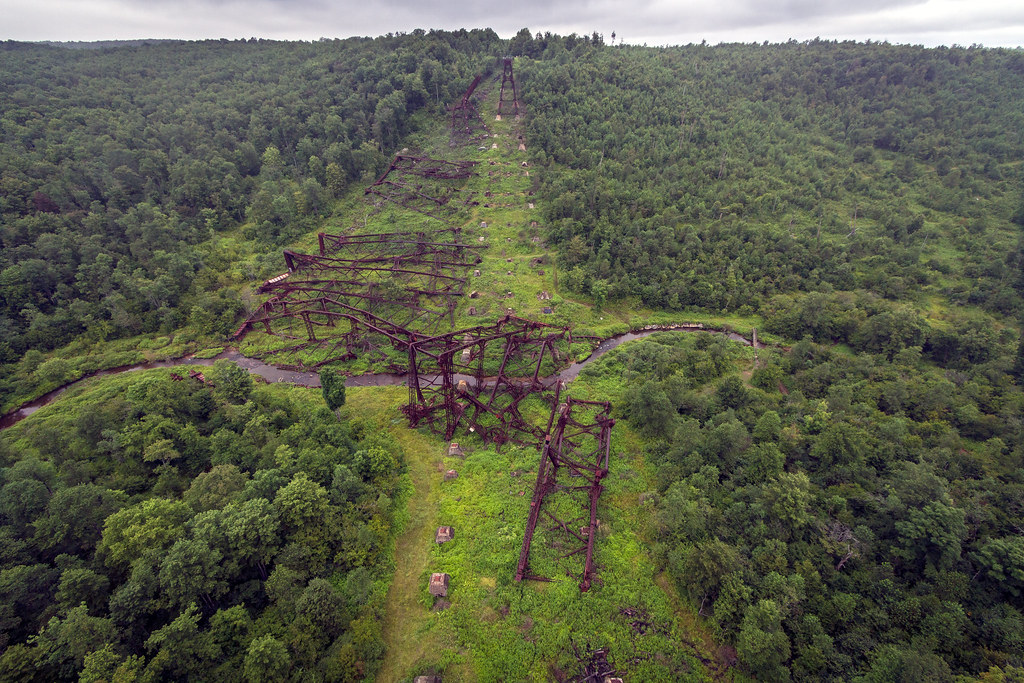The DU Lounge
Related: Culture Forums, Support ForumsTough luck, 14 years and one day ago, Kinzua Viaduct
I'm a big fan of railroad bridges and tunnels. I walked across quite a few bridges and through many tunnels. I first saw this bridge in October 1975. It was really an engineering marvel.
Back then, you could walk across it. On that day, it looked just as it does in the first picture .
Kinzua Viaduct


Historic American Engineering Record (HAER) photo of the bridge in July 1971. The picture is by Jack Boucher.
The Kinzua Bridge or the Kinzua Viaduct (/ˈkɪnzuː/ or /ˈkɪnzuː.ə/) was a railroad trestle that spanned Kinzua Creek in McKean County in the U.S. state of Pennsylvania. Before its collapse in 2003, the bridge was 301 feet (92 m) tall and 2,052 feet (625 m) long.
....
Before its collapse, the Kinzua Bridge was ranked as the fourth-tallest railway bridge in the United States. It was listed on the National Register of Historic Places in 1977 and as a National Historic Civil Engineering Landmark in 1982. The ruins of the Kinzua Bridge are in Kinzua Bridge State Park off U.S. Route 6 near the borough of Mount Jewett, Pennsylvania.
....
Destruction
On July 21, 2003, a tornado struck the Kinzua Bridge, snapping and uprooting nearby trees, as well as causing 11 of the 20 bridge towers to collapse. There were no human deaths or injuries.
....
When the tornado touched down, the winds had increased to at least 94 miles per hour (151 km/h) and were coming from the east, perpendicular to the bridge, which ran north–south. An investigation determined that Towers 10 and 11 had collapsed first, in a westerly direction. Meanwhile, Towers 12 through 14 had actually been picked up off of their foundations, moved slightly to the northwest and set back down intact and upright, held together by only the railroad tracks on the bridge. Next towers four through nine collapsed to the west, twisting clockwise, as the tornado started to move northward. As it moved north, inflow winds came in from the south and caused Towers 12, 13, and 14 to finally collapse towards the north, twisting counterclockwise.
The failures were caused by the badly rusted base bolts holding the bases of the towers to concrete anchor blocks embedded into the ground. An investigation determined that the tornado had a wind speed of at least 94 miles per hour (151 km/h), which applied an estimated 90 short tons-force (800 kN) of lateral force against the bridge. The investigation also hypothesized that the whole structure oscillated laterally four to five times before fatigue started to cause the base bolts to fail. The towers fell intact in sections and suffered damage upon impact with the ground. The century-old bridge was destroyed in less than 30 seconds.
This is what it looked like after it collapsed.
In this one, you're looking almost due north:

This is looking to the northeast:

A HERETIC I AM
(24,365 posts)What I find fascinating is that the railroads used to build similar structures entirely out of wood;

pansypoo53219
(20,972 posts)but its gone.
A HERETIC I AM
(24,365 posts)old trestles. I can speak from experience in the UP of Michigan, where many hundreds of miles of old Railroad right-of-way has been transformed into hiking, cycling and snowmobile trails, and as such dozens of old trestles have been preserved. How well they are maintained is another issue, but they haven't been destroyed, anyway.
Old roadbeds and rail right-of-ways intrigue me for some reason. As an example, several miles of the road that James Dean was traveling when he was killed is abandoned and parallels the newer road (CA 46), from Kecks Corner to Cholame, east of Paso Robles, CA. I see many, many such abandoned roads and railways as I drive across this country and wonder who traveled them and what their stories were.
Pennsylvania has many miles of such roadway, including parts of the Pennsylvania Turnpike, including tunnels.
Fascinating. Truly.
NNadir
(33,512 posts)...after they were destroyed (by military action) in a matter of days, this without access to any kind of heavy equipment.
The most notable example of this took place during General Sherman's campaign in Northern Georgia.
The story goes that among his confederate opponents they would say that there was no point in blowing up a tunnel since Sherman carried spare tunnels with him.